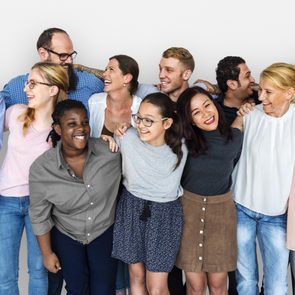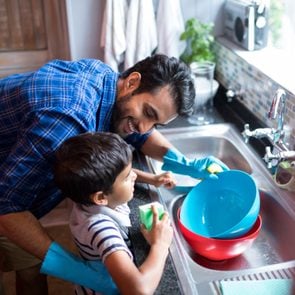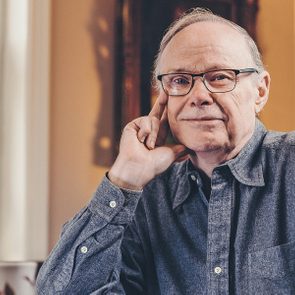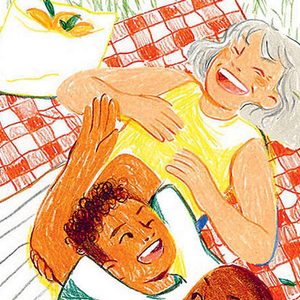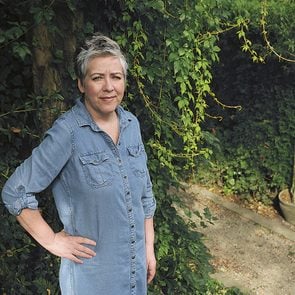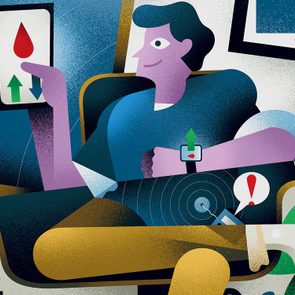
Five years ago, Meredith Arthur, a 45-year-old San Francisco employee of the social media company Pinterest, arrived at a neurologist appointment in a distraught state. She spoke a mile a minute, rattling through her extensive research on the vagus cranial nerve and explaining why she thought it might hold clues to her crippling shoulder and neck pain, frequent dizziness and nausea and chronic migraines. “I was presenting my inexpert case to an expert, and she stopped me and said, ‘I know what’s wrong. You have generalized anxiety disorder.’”
For Arthur, the diagnosis was a shock. She had been so focused on her debilitating physical symptoms that she hadn’t considered that they could be linked to her mental health. But almost immediately, it clicked.
“My brain was always in overdrive, from early childhood,” Arthur recalls. “I always wanted to work really hard all the time and solve everything.”
She would have never described herself as a worrier, however, and certainly didn’t connect her perfectionism to anxiety or its impact on her body. But in fact, physical discomfort (like stomach and chest pain, feeling restless or irritable, sleep problems, fatigue and muscle aches) is most often what drives people with anxiety to seek treatment, not distressing thoughts.
“The diagnosis changed everything,” says Arthur. “It’s like somebody picked me up off the earth, turned me around 180 degrees and put me back down. It was the same world, but everything looked a little different.”
Arthur is one of the 44 million North American adults who experience an anxiety disorder—the most common form of mental illness—every year. But beyond serious cases, anxiety is something that touches everyone to varying degrees. Typically, it’s intermittent and brought on by a stressful or traumatic event. The core features of anxiety are excessive fear and worry—followed by extreme problem solving, in Arthur’s case—and one of the major underlying factors is a feeling of uncertainty about situations that occur in daily life.
Enter big, bad 2021. These are exceedingly anxious times due to the unholy combination of economic precariousness, social unrest, political volatility, environmental catastrophes (pause: deep breath) and the COVID-19 pandemic. But an individualized, holistic approach to managing anxiety—including lifestyle tweaks, medication, mindfulness exercises and, to begin with, acceptance—will ensure it doesn’t rule your life.
What Anxiety Does to Your Body
Anxiety is part of your body’s stress-response system—and it’s uncomfortable, overwhelming and sometimes plain confusing.
“I describe anxiety as a future-oriented emotional response to a perceived threat,” says Dr. Joel Minden, a clinical psychologist and the author of Show Your Anxiety Who’s Boss. “We anticipate that something bad will happen. Maybe we have evidence for thinking that. Maybe we don’t. But we have a belief that something catastrophic might occur.”
Almost immediately after that, Minden says, your sympathetic nervous system, which controls involuntary processes like breathing and heart rate, kicks into high gear. This leads your adrenal glands to release adrenalin and cortisol, two of the crucial hormones driving your body’s fight-freeze-or-flight response, which prompt anxiety’s physical symptoms. Your heart races, your blood pressure rises, your pupils dilate, you get short of breath and you break out into clammy sweats.
Meanwhile, cortisol curbs functions that your brain considers nonessential: it alters immune-system responses and suppresses the digestive system, the reproductive system and growth processes. This was helpful for our ancestors trying to outrun a sabre-toothed tiger, but not so much when you walk past someone in a grocery store and, even though you’re both wearing masks, can’t stop ruminating for days afterward about whether you might have caught COVID-19 when they coughed.
“The physiological sensations you get make sense when you’re in danger,” says Dr. Melisa Robichaud, a psychologist and clinical instructor in the University of British Columbia’s psychiatry department. “But they feel odd and sometimes quite scary when there’s no physical threat.”
Everyday Anxiety or an Anxiety Disorder?
For Arthur, chronic physical pain and discomfort were the most powerful manifestations of her disorder, but anxiety can show itself in many ways. You might perceive something as threatening, even when it isn’t, or go to great lengths to avoid uncomfortable situations. You might constantly overthink plans or spend all of your time creating solutions to worst-case scenarios that are unlikely to happen. Maybe you’re indecisive and fear making the wrong decision. Or you might find yourself unable to relax and feel restless and keyed up.
Often, those symptoms last only as long as a certain situation or problem is present. (You may feel nervous about flying, but you do it and the feeling fades when the wheels touch down.) But sometimes anxiety can tip into a chronic anxiety disorder. These include generalized anxiety disorder, but also panic disorder, social anxiety disorder, obsessive-compulsive disorder, post-traumatic-stress disorder and phobias. People with an anxiety disorder can also suffer from depression—and in fact, some estimates show that 60 per cent of those with anxiety will also have symptoms of depression.
The distinction between circumstantial or temporary anxiety and a more severe case isn’t always easy to make, says clinical psychologist Dr. David Carbonell, founder of the Anxiety Treatment Center in Chicago.
“There isn’t a blood test for anxiety. At some point, everybody experiences it,” he says. “It becomes a disorder when it interferes with your behavioural choices and your ability to do as you wish in life.”
For instance, that point could be when your job requires you to fly, but you’re too anxious to even make it as far as the airport, which ultimately puts your livelihood in jeopardy. Or, more generally, when you find that anxious feelings last for a long time, beyond when a problem has passed or been resolved, and they seem to jump from one situation to the next without relief.
Despite the fact that chronic anxiety is very manageable with professional help—and some combination of medication, therapy and lifestyle adjustments—only about 37 per cent of affected people receive treatment of any kind. “I always say that I have a really good job because I specialize in treating people who have anxiety disorders,” says Robichaud, “and by and large, most everyone I see gets better.”
How to Treat an Anxiety Disorder
1. Accept It
Just like happiness and sadness, anxiety is part of everyone’s lived experience—but it’s not always tolerated as such.
“People spend too much time and effort on trying to control anxiety,” says Minden. “I encourage them to remember that anxiety is a normal emotional response.” If you try to banish it, he adds, all you’re doing is putting it more at the forefront of your mind. But if you accept anxiety as part of life, you can learn to relate to it with self-compassion or even with humour. This is a cornerstone of acceptance and commitment therapy (ACT), which has been gaining clinical validation, including by the American Psychological Association.
ACT guides people to see their unpleasant emotions as just feelings and to accept that parts of life are hard. Practitioners encourage patients to begin a dialogue with anxious thoughts, examining their causes while also keeping in mind their personal goals and values. Although anxious thoughts shouldn’t be completely suppressed, sufferers can deliberately not allow anxiety to decide what gets their attention or turn them away from what they want to do and who they want to be.
This way of relating to anxiety has been a powerful strategy for John Bateman, the 52-year-old host of the podcast Our Anxiety Stories. When negative or irrational thoughts arise, he acknowledges them but doesn’t let them drive his decisions.
Over the years, Bateman has noticed that if he acquiesces to his thoughts, they don’t go away but dramatically increase. But if he recognizes them for what they are, just a passing thought and not a fact that needs to be acted on, they diminish. Since beginning to train his brain to think in this new way eight years ago, he’s noticed that the negative thought patterns have lessened. “I discovered that my brain is this amazing, elastic thing,” he says.
2. Be Curious About It
After acceptance, a mindfulness approach to anxiety can be useful, especially when you’re cycling through anxious thoughts and are unable to think clearly or rationally.
In his book Unwinding Anxiety, psychiatrist and neuroscientist Dr. Judson Brewer recommends paying attention to the body sensations, thoughts and emotions that come as a result of feeling anxious or worried. When we notice and name the physical sensations that are arising in our bodies (my face feels hot and flushed; my breathing is shallow; my heart is beating quickly; I feel sweat prickling my underarms), we are already less caught up in it, simply through that act of observation, writes Brewer.
Many mindfulness training apps can provide you with help, including one that Brewer developed in his lab at Brown University and shares a name with his book. After three months of using the app, a test group reported a 57 per cent reduction in their anxiety.
Understanding exactly what was happening inside her body and bringing her awareness to it was an empowering tool for Arthur. When she’d notice the shaky feeling in her chest or belly that radiated out to her hands and down her legs, she knew that meant adrenalin had been released. And by noting these changes as an observer, her “thinking brain” could take over from her immediate fight-freeze-flight reaction to an anxious moment—and as she began processing what just happened, her symptoms became less acute and threatening. She pictured the hormones hitting her body the same way an ocean wave hits the beach. The beach can’t fight the wave, but it remains steady and allows the wave to wash over and fall back.
3. Make Lifestyle Adjustments
Learning to live with anxiety is an individual process, and one that requires trial and error to get just right. While acceptance is the first and most important step to take, some lifestyle changes have been proven to take the edge off, as well.
Since fatigue and increased tension and stress leave us more vulnerable to anxiety, a well-balanced diet, adequate rest and, especially, regular exercise can help us manage it better. In one study, researchers showed that regular vigorous workouts lead people to be 25 per cent less likely to develop an anxiety disorder or depression over the next five years.
Meredith Arthur’s toolkit consists of medication—a prescription SSRI antidepressant—and regular meditation. She also shares her experiences on and edits stories about mental illness for the web platform Medium and recently wrote Get Out of My Head, an illustrated guide on how to understand anxiety and learn to navigate problems without overthinking.
Openly discussing the condition with an online community and readers has transformed her relationship with anxiety. “I’m learning to live in harmony, as much as possible, with this thing that is a part of me,” she says. “It’s not always pleasant, but I’m learning to accept and, as much as I can, take care of my anxiety.”

There’s No Shame in Taking Medication
Many people avoid taking, or even looking into, medication for anxiety because of the stigmas associated with psychiatric drugs. They may worry about dangerous side effects, that they’ll become dependent on them or that loved ones will see them as weak or flawed.
But the fact is, modern pharmacological treatments for anxiety disorders are safer and produce fewer side effects than they did 30 years ago. At the same time, attitudes toward mental illnesses are improving: a 2019 survey by the American Psychological Association found that 87 per cent of adults agreed that having a mental-health disorder is nothing to be ashamed of.
If you’re ready to explore medication, Dr. Debra Kissen, CEO of Light on Anxiety CBT Treatment Center, suggests talking to a primary care doctor, who can prescribe the medications most commonly taken for anxiety.
Selective serotonin reuptake inhibitors (SSRIs) are considered a good starting medication for many forms of anxiety. Serotonin is a neurotransmitter that plays a role in feelings of well-being and happiness, as well as thinking, memory, sleep, digestion and circulation. SSRIs increase levels of serotonin in the brain and are considered non-addictive and safe for long-term use.
Another choice is benzodiazepines, or “benzos,” which strengthen the effect of the neurotransmitter GABA—the primary inhibitory (“turn off”) signaller in the brain. Benzos are fast-acting and don’t stay in your system for long, but they are considered unsafe for continuous use and are potentially addictive.
Kissen believes therapy is still crucial because the gains are hardwired into your brain. For moderate to severe anxiety, combining therapy with medication is generally the most impactful. “It’s a one-two punch where the medication is setting up the environment of your brain to make the most rapid gains as you’re doing the work of learning new ways of looking at situations,” says Kissen.
Next, check out these tips that will help you live to 100!

Last spring, when the first lockdown began in Winnipeg, the task to check in daily on our elderly mother fell to me. I was no longer working in an office, and since I lived alone, I could more easily limit social contacts and ensure her safety.
My brother and sister-in-law handled the weekly grocery shopping (dropped off at the side door) as well as Mom’s monthly haircut (with her seated smack in the centre of the backyard on a white-gone-grey plastic lawn chair).
Mom is 88 and lives on her own in the home she and my father moved into after their retirement. Dad passed away about 12 years ago—he fell ill just as my parents were about to celebrate their 50th anniversary.
She’s blessed, of course, to have her two sons and three grandchildren nearby, and my brother and I are lucky even to have been able to visit her. Still, I wasn’t sure how the visits would go. Mom and I agreed long ago that we have clashing personalities and, even as I’ve crossed into my late 50s, our differences still present challenges. She appreciates discipline and order; I favour improvisation. We do share a facility with language—but, unfortunately, when directed at each other, it can be biting.
Initially, I timed my visits to coincide with the Greek game shows she watches every afternoon on satellite TV. The ice-breaker worked: soon we found ourselves rooting for the same contestants or comparing the relative appeal of the various hosts.
Mom became fascinated with my ability to find out trivial information almost instantly on my smart phone: the age of a Greek pop singer, the selling price of the house down the street, the year an acquaintance married.
“How can that little thing know so much?”
What I discovered when we turned away from the TV, however, was that my mother knew things Google didn’t. Soon I set aside my phone and made Mom my preferred search engine. I learned, for instance, that the German soldiers occupying her hometown south of Sparta during the Second World War sunbathed in the nude every afternoon, and that the trick to cooking wild dandelion greens so they are only slightly tart and still deliciously tender is not to over-boil them.
My mother also revealed family histories I wasn’t aware of: that as a child she enjoyed climbing trees and throwing stones; that in 1934 my paternal grandparents lost their twins—two boys not yet six months old—on consecutive days to a mysterious “grippe” virus; that my mother had only ever seen snow once before coming to Canada; and that my father, in their first years of marriage, had earned her lifelong loyalty by agreeing without argument to pay for her own mother’s new dentures.
I was hooked. Soon I was visiting twice a day.
On about Day 12 of that initial lockdown, Mom’s landline went dead. I called the phone company and learned the problem could last as long as a week. The customer service rep was surprised Mom didn’t own a cellphone and recommended we buy one for her to tide her over.
“We’ll call the television news,” I joked to mom, “and invite them to interview the octogenarian learning to use a cellphone for the first time.”
Mom wasn’t amused. We nixed the cellphone idea. But now the issue remained of how she would contact anyone in the event she needed help. We decided it was best if I slept over until the landline was repaired. I packed my overnight bag.
“I get up a few times a night, I’m just warning you,” she told me.
“It’s okay,” I replied. “So do I.”
She laughed: “I guess so. I’m only 30 years older than you.”
The week living together went surprisingly well. Never a handyman, I nevertheless tried my best to make myself useful. I changed a light bulb, found a discarded piece of baseboard with which she could easily switch the television on and off, and took her reading glasses in for repair when the toothpick I tried as a temporary fix to replace a screw didn’t quite do the trick.
When we weren’t addressing the long list of deferred household maintenance chores, we planned the day’s menu, went for walks down the street and continued our open-ended chats.
One night at bedtime, which was signaled on weekdays by the 9:00 p.m. closing credits of the Seattle broadcast of Wheel of Fortune, she turned to me and said: “Now I’ve learned your character.”
I didn’t ask her to elaborate. But, choosing to interpret the gleam in her eye as an indication that her conclusion was a favourable one, I found myself struggling to keep from choking up.
One afternoon well into the second month, after the phone was working again, I called Mom to let her know I was coming by. No answer. I dismissed any negative thoughts. I drove over and knocked at the door. Again, no answer. Now I was getting worried. I called my brother and the friend down the back lane my mother often visited pre-pandemic. Neither had heard from her that morning. I retrieved the extra set of house keys from my car and let myself in. My heart thumped. I checked the upstairs rooms, the basement. No Mom. I realized I hadn’t checked the bathtub. I steeled myself for the worst, pulling the shower curtain aside.
Nothing.
I got into my car and headed down the street. Maybe she’d taken a walk. I spotted a police cruiser parked outside a fast food outlet. The officers might have spotted her somewhere, or at least I could report her as a missing person, I decided.
As I swung into the strip mall parking lot, there was Mom walking down the adjacent sidewalk, sunglasses shading her eyes, a grocery bag hanging at her side.
I was too relieved to chastise.
“I’ll drive you home,” I offered.
“I’m fine, thanks,” she said. “I just needed to do something myself.”
I smiled. “I was ready to have the police track you down.”
“Don’t worry,” she said. “It won’t happen again. I don’t like all the new rules. The cashier scolded me for resting my purse on the checkout counter.”
Now, over a year after our lockdown journey began, the pandemic hasn’t given up. But neither has Mom. The winter months were the hardest, forcing her to remain indoors more than she’d have liked. Her spirit, though, remained as indomitable as ever.
The year has not been without loss, however. At least a dozen of Mom’s friends have died, and so has one of my own.
“The shovels, the spades and straight to Hades,” my mother intoned recently in rhyming Greek, calling up one of the countless Old World aphorisms in her repertoire. I guess when you’ve lived almost 90 years, you come to realize that the end of life is always near.
In the meantime, Mom is eagerly anticipating her COVID-19 vaccine. And like so many other grandparents, she’s looking forward to safely hosting her grandchildren again. There’s even phyllo pastry waiting in the freezer for the day she can bake a spanakopita for us all.
Physical distancing measures notwithstanding, my generation fully expects to visit our parents as they are dying, usually in hospital; I’ve learned that the real reward comes in visiting them as they are living.
With at least some level of pandemic restrictions still in place, my sessions with Mom have become the highlight of my day. Some days I drop by as many as three times.
I like to believe the time spent with her is good for my character.
Next, read the heartwarming story of how casserole brought this family together during the pandemic.
© 2020, John Danakas. From “In Lockdown, Mom and I Are Learning to Reconnect,” The Globe and Mail (November 22, 2020), theglobeandmail.com

Last year, COVID-19 forced much of our lives online: work meetings migrated to Zoom, quarantinis replaced in-person happy hours. Medicine was no exception. In order to prevent the spread of the coronavirus, governments worldwide instructed their citizens to stay home when possible and avoid non-essential outings, including trips to hospitals and doctors’ offices. So, patients swapped in-person appointments for phone calls and video chats. Google searches for telehealth spiked. Before the pandemic, just one in 10 Canadians had used telehealth; by last May, half of them had.
To meet the increasing demand, North American and European governments, hospitals and private businesses have invested billions of dollars in new and existing virtual care services. The Canadian federal government, for one, earmarked $13.4 million for a trio of telehealth companies and a digital health “innovation hub,” while Loblaw Companies Ltd. invested $75 million in Maple, an app that facilitates online doctor consultations. As a result, hundreds of Shoppers Drug Mart stores are now outfitted with iPads that provide customers a direct link to Maple physicians.
Virtual visits are best suited to simple tasks, like refilling prescriptions, as well as diagnosing and treating conditions that rely on a doctor’s sense of sight—pink eye, rashes, varicose veins—or a patient’s description of symptoms, such as back pain, strep throat and UTIs. Telehealth also excels at monitoring chronic conditions, such as congestive heart failure, where doctors don’t need to provide a new diagnosis but simply check up on patients, monitor evolving symptoms and discuss the side effects of medication. Diabetes is also a good fit: people can upload blood sugar levels, dosing and other information for a nurse to review electronically.
Mental health counselling is easy to access digitally, too, though it comes with pros and cons. On the one hand, therapists may not be able to see body language, which can sometimes be a clue to understanding a client’s well-being, and a shoddy Internet connection can be particularly jarring during a difficult conversation. At the same time, there are patients who like it better. “Some providers even say having that extra bit of distance makes people more honest and less stressed to talk about difficult topics,” says Annette Totten, an associate professor at Oregon Health and Science University who has studied telehealth extensively.
When done right, Totten’s research shows, telehealth benefits both health-care providers and patients. It can significantly reduce hospital admissions, which frees beds for people in need of critical care—an especially crucial factor during the pandemic. And it’s a lot more convenient for patients, adds Michelle Greiver, a family doctor in Toronto whose entire practice shifted to telehealth when the pandemic hit. “They don’t have to take time off work or travel to our office,” she says.
Totten experienced that convenience firsthand last spring. When her husband accidentally spilled hot oil on his arm, she suggested they arrange a video call with his doctor instead of rushing to the hospital, where they risked getting infected with COVID-19. Over video chat, the doctor inspected Totten’s husband’s burn, instructed him how to bandage it and prescribed him painkillers.
According to a May 2020 survey by the Canadian Medical Association, 91 per cent of telehealth users were “very satisfied” with their experience. To ensure visits go smoothly, Totten recommends preparing for appointments with a list of questions and to ask for written instructions about next steps. Patients can avoid wasting precious minutes of their appointments by ensuring beforehand that their Internet connection is strong and that they have all the necessary software and hardware.
Online or off, some doctors are better than others. If patients aren’t satisfied with an experience, they can look for another telehealth provider—there are plenty. Many hospitals and public health systems have telehealth programs, and some startups offer instant access to doctors—for a fee. Maple, the Loblaw-backed app, charges between $49 and $99 for a one-off virtual visit.
Of course, there are times when telehealth just doesn’t cut it. “Diagnosis is an art, and doctors take in information from lots of places,” says Totten. “There are things that involve touch or smell that you’re not going to get through telehealth.” For example, doctors regularly use their hands to examine potential tumours, hernias and fractures, while a foul odour may hint at poor general health.
For maternal health, expectant mothers should still make the trip to the obstetrician. The same is true after birth, since babies can’t communicate their health concerns and regularly need immunizations. And urgent health matters—a broken bone, prolonged shortness of breath, symptoms of a heart attack or stroke—should still push patients to the ER, not their iPads.
Greiver expects the uptick in telehealth use to last after the pandemic. At her clinic, she says, much can be taken care of by phone. “I don’t think we will go back to as many in-person visits as before. It’s just not needed to provide the best possible care.”
Telehealth Intel
Are there virtual “walk-ins” if you don’t have a doctor?
Yes, many brick-and-mortar walk-in clinics have begun offering virtual visits during the pandemic. These appointments, which are covered by provincial health plans, may require you to book hours or even a day in advance, whereas services like Maple and GOeVisit can provide near-instant access to licensed doctors around the clock for a fee.
Who is using telehealth the most?
The demographic skews young and, at least prior to the pandemic, rural. According to a May 2020 survey by telehealth provider MDLive, 72 per cent of respondents aged 18 to 44 said they would “probably” or “definitely” use telehealth, whereas only 61 per cent of 45-to-65-year-olds said they would.
Do you need to worry about privacy?
Yes, within reason. Patients would be wise to ask their chosen provider what data-protection measure they take, and also scan and search news sources to make sure there are no reports of data misuse on the part of the company.
From cutting back on social media to helping others, these self-care ideas will help you find your happy place.
The pandemic has made me a more spontaneous person. Weird, I know. Before COVID-19, I was very Type A about my social life: dinner at 6 p.m.—6:30 if I was feeling sassy—usually at a restaurant of my choosing that I’d researched and booked with three other moms, four weeks in advance. The upheaval of this last year completely changed my Virgo approach to recreation.
Now, with so many activities off the table, whenever there’s a chance to do anything, I jump. Socially distanced falafel in the park? Sounds glamorous! Walk with an acquaintance who lives around the corner? My new BFF! Lawn cocktails with the neighbour? Why didn’t I think of this before?
My new “Sure, why not?” vibe has been one of the surprising upsides of this time. I’ve made some new friends, seen parts of Toronto I didn’t even know existed and become extremely good at dropping everything at a moment’s notice.
I’ve also learned that embracing novelty and openness to new experiences can make us happier—even if it’s confined to small changes in our daily routines. Here are some easy ways you can give spontaneity a fighting chance to thrive.
Focus Your Efforts
Someone who’s naturally more introverted or anxious doesn’t need to revamp their entire approach to life to reap the benefits of spontaneity, says Steve Joordens, a psychology professor at the University of Toronto, Scarborough. The key, he says, is to identify which areas are the ones you feel could benefit from a little more of an off-the-cuff approach and focus on changing your habits there.
“The first step is asking yourself what’s lacking in your life,” he says. “What’s your goal?” Once you identify your aim—more friends? A new hobby? Getting out of a fashion rut?—you then need to identify which habits are keeping you from getting what you want. Maybe your weekend routine is too packed or too rigid, or you keep making flimsy excuses to not try that new online baking class.
Then you can consciously substitute those spontaneity-killing habits for ones that will help you achieve your goal. If this doesn’t exactly sound spontaneous, that’s because it isn’t—at least not at first. “It’s just like going to the gym,” says Joordens. “You may have to force yourself in the beginning, but then hopefully it becomes your new habit.”
Make Some Room
Having gaps in my day, thanks to the widespread closures of restaurants, bars and movie theatres, definitely helped foster the creation of Brave-New-Why-Not?-Leah. I could accept last-minute invites for bike rides or phone chats, and I quickly learned the small joys of unexpected fun.
According to Edward Slingerland, a professor of philosophy at the University of British Columbia, the first thing you need to do to nurture spontaneous experiences is to create some space for them. The author of Trying Not to Try: Ancient China, Modern Science and the Power of Spontaneity, he became interested in spontaneity while studying Chinese philosophers who wanted to cultivate a state of Wu Wei, or effortless action, and saw spontaneity as an important goal.
“We overstructure our lives and plan too much,” he says. “Most people don’t have any gaps in their day to play.”
And while Slingerland admits that leaving those gaps is definitely trickier if you’re juggling things like work, taking care of family members or a busy volunteering schedule, even just having the mental goal of not overscheduling yourself can help change your approach. Many rabid list checkers (guilty!) might also be initially baffled as to how to put this into practice.
“Spontaneity is this weird combination of trying and not trying,” says Slingerland. He suggests giving yourself a very loose goal—like, say, going for a walk without a particular destination or just put “leaving the house” on your agenda—to help build the scaffolding for interesting things to happen. You just have to get comfortable with the idea that you might not always be “accomplishing” something, per se.
Another quick way to give spontaneity a fighting chance? Stop scrolling. Screen time, says Slingerland, is a “black hole” for adults and children alike. “Digital addiction is a real barrier to spontaneity,” he adds. The modern instinct to reach for our devices at the first hint of empty time (guilty again!) eats up both actual time when we could be engaging with our environment in a more present way and the sudden mental breakthroughs that can occur when we let our minds wander.
You’re not going to strike up that interesting conversation with the person next to you in line if both of your faces are buried in your phones. And you’re not going to notice that you’ve just passed a cute new bakery if you’re too busy checking email as you scurry by. So put your phone down and embrace the unexpected world around you.
Embrace Failure (No, Really)
Learning to not fear failure is a daunting but essential step in the path to becoming more spontaneous.
“The hardest thing for a non-spontaneous person is going to be that risk,” says Joordens. Even though we’re not necessarily talking about capital-B Big Risks here, even making small changes to your routine can be enough. Your partner might not like that new bedroom idea; you will perhaps look silly if you take up tap dancing (okay, you will look silly); it could be a flop if you stream that movie you know nothing about. The trick, says Joordens, is to take a cue from the entrepreneurial world and try to reconceptualize failure as a learning opportunity.
“Entrepreneurs embrace failure and the notion of learning from it,” says Joordens. “The upside is if you’re spontaneous, you’re more likely to discover something new, and that could turn out to be something you really love.”
Next, here’s why learning new skills as an adult is easier than you think.
For much of last summer, I was serenaded by a chorus of circular saws, lawn mowers and wood chippers outside my Toronto apartment. Some days, a mysterious banging from a nearby neighbour joined in. If you’ve spent the pandemic mostly working from home, you’ve probably become well acquainted with the sounds around your home, too. Not all of them have been pleasant! But if you listened closely and ventured out into the streets, you might have also heard something else—or rather, a surprising lack of something else, for city dwellers and suburbanites alike. The birds seemed louder. Voices carried further. In some places, construction had even paused.
The sudden shift was palpable. With fewer cars on the road, noise measurements in cities across Canada, the U.S. and Europe dropped significantly. Seismologists could actually see our behaviour shift, the usual vibrations of human activity now dulled. Microphones in cities around the world captured what The New York Times called “human-made environments suddenly stripped of human sounds.” Our cities, once loud, had been silenced. It was tempting to wonder: what if life were this quiet all the time?
Noise is too often thought of as a personal problem and not a societal concern. But Tor Oiamo, an assistant professor of geography and environmental studies at Ryerson University, hopes his research will make you think differently. For over a decade, Oiamo has been studying the long-term health effects of background or environmental noise—the minimum level of noise observed in an environment, the kind of noise so pervasive, so part of the fabric of daily life, that it could never justify a complaint to the city.
“What comes to people’s minds most of the time when they think about noise,” says Oiamo, “are things like your neighbour doing construction, or the dog, or concert events—these things that basically stand out from background noise levels.”
As annoying as these daily intrusions may be, they don’t pose as much of an impact on our health as the chronic, long-term nuisances we’ve learned to cope with or ignore. That is, the constant thrum of highway traffic, manufacturing and warehouse activity—the stationary sounds that ripple outward day after day, year after year. This is the kind of noise you might have never noticed until quarantine turned the volume down in 2020.
Aside from the obvious impacts excessive environmental noise has on sleep, mood and quality of life, it’s also detrimental to cognitive, cardiovascular and mental health, according to the World Health Organization. The people who suffer the most tend to be among our cities’ most marginalized and disadvantaged, while quiet is for those with privilege and money. While what we hear in the foreground certainly matters, there’s mounting evidence that the background noises so many Canadians have learned to cope with or tune out deserve our attention, too. All it took was a global pandemic for us to hear the difference.

A Noisy History
The soundscape of our cities in the early 20th century was a cacophonous din: trucks rumbling, newsboys shouting, streetcars screeching, milk bottles clattering, children screaming, radios blaring, factories whistling, dogs barking and, most hated of all, car horns honking at all day and night.
By the mid-1920s, the anti-noise movement was in full swing. Organized campaigns decried “needless noise” and urged order be brought to the city. Noise was deemed unneighbourly. G.R. Anderson, an acoustics professor at the University of Toronto known all over Canada as “the Noise Professor,” was a fixture in the press. He used a cutting-edge portable sound-measuring device called an audiometer to rank the city’s worst offenders (number one: streetcars).
Adelaide Plumptre, only the third woman to serve on Toronto city council, proposed a bylaw against “unnecessary noise,” and on June 26, 1939, it came into effect. Shouting, honking and bell ringing were outlawed. Old cars had to run quietly. Radios had to be turned down low. People could be fined up to $50 for each offence—the equivalent of more than $900 today.
Toronto’s anti-noise efforts took cues from New York City, where the mayor, Fiorello La Guardia, waged his own “war on noise.” In 1936, the city passed one of the first comprehensive noise bylaws in North America. La Guardia, wrote cultural historian Lilian Radovac, “approached noise as an aural barometer of the chaos of New York City,” both as a symptom and a cause of urban disorder. Noise went from something city builders tried to mitigate to a moral failing to be policed, licensed and controlled.
In reality, noise complaints in New York were used as a pretext to hassle the original Black and immigrant residents of gentrifying neighbourhoods, to disrupt political protests and strikes, to get merchants off the sidewalks and children out of the streets and to maintain the status quo. In Toronto, the city’s police chief, D.C. Draper, sought authority to deny vehicles with loudspeakers permission to participate in parades. And noise bylaws are still wielded against marginalized groups today.
Radovac points to the cancellation of Carnival Kingdom, a Caribbean culture and music festival held in Vaughan, Ont. in 2018, after the city received complaints of excessive noise. “Why? Is it because they’re Black? Is it because these sounds aren’t perceived to have a wider community value, like the Air Show?” says Radovac. “When you look at what gets shut down and what doesn’t, who gets targeted and who doesn’t, patterns start to emerge.”
While noise complaints have long been used as a cover for racism, classism and political opposition, there is something that some early anti-noise campaigners got right: certain types of environmental noise can be incredibly harmful to human health.
Noise and Our Health
With the 1960s came the promise of supersonic flight. Oklahoma City had aspirations of becoming America’s first supersonic hub. But no one quite knew how its residents would deal with the sonic booms. “Would everyone eventually adapt, or would the country be slowly driven insane?” wrote Sam Anderson in his 2018 book, Boom Town. The answer was Operation Bongo, a six-month U.S. government campaign to subject the residents of Oklahoma City to multiple sonic booms each day, varying in intensity. As you might expect, residents were anxious, frustrated and very annoyed.
Much as cars had remade the soundscape of the streets, air travel remade the soundscape of the sky. Soon, noise was seen as an environmental scourge on par with pollution and became a full-blown public health issue in the 1990s. A growing number of studies suggested links between excessive noise exposure and chronic adverse health effects, from heightened blood pressure to cognitive impacts on memory, performance and concentration.
There are many to choose from, but one 2011 study of the Danish population found that people aged 65 and over faced a 27 per cent higher risk of stroke when noise exposure went up by 10 decibels (dB). A separate study by some of the same researchers linked a 10 dB increase in traffic noise with a 12 per cent higher risk of heart attack.
Ryerson’s Oiamo and his colleagues published the first comprehensive study of environmental noise in Toronto with the city’s public health department in 2017. “The number of people exposed to harmful levels is most definitely increasing,” Oiamo says. Unsurprisingly, the study found that road traffic contributed 60 per cent of background noise, and people living near major roads, highways and mixed commercial areas were especially vulnerable to excessive levels.
Over 60 per cent of Toronto residents experienced traffic noise levels above 55 dBA during daytime hours. (While dB measures sound intensity, the term “dBA” refers to both sound intensity and how the human ear responds to it.) And while that level dropped to 50 per cent of residents at night, this level of noise still exceeds World Health Organization guidelines of 53 dBA for road traffic during the day and 45 dBA at night. Over a 24-hour period during weekdays, the overall average noise levels for Toronto were about 63 dBA—about as loud as a normal conversation, but one that never ends. (Montreal and Vancouver both have similar noise levels.)
Lower-income areas were almost 11 times more likely to have half their residents exposed to excessive nighttime noise than higher-income areas. Put another way, a quiet life is a privileged life, available to people who can afford a well-insulated unit, a detached suburban home on a residential street or an apartment on the upper floors of a building, nowhere near the street at all.
Given all this, you would think we would be more concerned. “We’re seeing long-term effects on hypertension, diabetes and cardiovascular disease,” Oiamo says—effects that can be even worse for people in lower-income or marginalized communities, who often have more limited access to health care, are more likely to be stressed and in general have lower life expectancy. Why, then, don’t we treat environmental noise the way we do other sonic intrusions in our lives?
What Cities Are Doing to Help
Before the pandemic, Toronto’s two most frequent noise complaints were related to construction and amplified sound. It’s not hard to see why. They’re the types of intrusions you can’t help but notice, the exceptions to the norm. “When you’re in your apartment and your neighbour is blasting music, you can pinpoint who it is, where it’s coming from and why you hate it,” said Radovac.
The city has 24 dedicated bylaw officers who respond to noise complaints from 6 a.m. to 2 a.m. the next day. Officers use sensitive, objective measuring devices to ensure compliance with newly set decibel limits. But background noise is more pernicious. It’s always there—and there’s nothing you can do about it, not by yourself. You can’t complain to 311. In fact, the city’s bylaw officers take into account background noise from distant highways and industrial work in their readings when investigating a noise complaint.
As a society, there are different levers we need to pull. In October 2019, Toronto released a noise action plan “aimed at reducing exposure to ambient environmental noise over time” (Vancouver and Ottawa have also released guidelines in recent years). It recommended that public-transit agencies prioritize noise mitigation in their planning and adopt more electric vehicles. Speed limits could be reduced, freight trucks rerouted and roads kept in better repair. Beyond Toronto, the national building code now requires more comprehensive soundproofing—something Radovac says would go a long way toward separating people from harmful noise levels. To measure and understand how noise levels change over time, Montreal has even proposed the creation of a city-wide noise observatory, essentially a permanent version of Oiamo’s Toronto study.
The goal shouldn’t be to make our cities quieter but to reduce the number of people, and types of communities, exposed to harmful levels of sound. Doing so won’t be easy; it will require us to confront multiple interconnected inequities at once. In Toronto and Montreal, research has shown that Black residents and residents of colour are those most impacted by noise. They’re also the ones who the pandemic has affected most. You can’t treat one and not the other when the underlying causes are the same.
As pandemic restrictions loosen, people are slipping back into their old routines. Factories and warehouses are humming again. Cars have returned to the road. The background noise is, well, back. The saws, the mowers, the mysterious hammering are still as annoying as ever, but remember, they’re merely temporary neighbourhood nuisances. The real threats are harder to hear because they’re always there—a part of the soundscape itself.
© 2020, Matthew Braga. From “How Noise Shaped a City,” from The Local (August 25, 2020), thelocal.to

